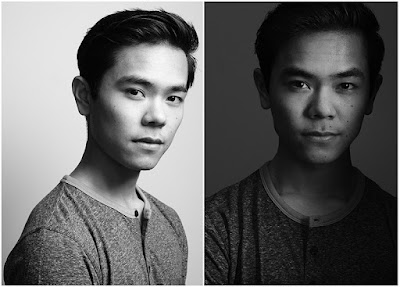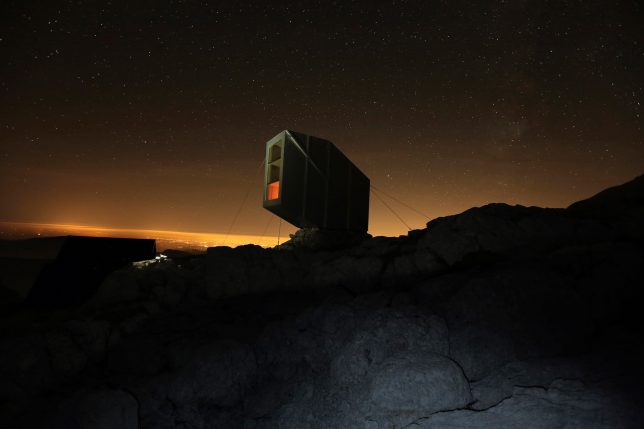Professional architectural and landscape photographers use tilt-shift lenses to avoid converging vertical lines and to get the entire scene in sharp focus. Portrait and food photographers use them to create interesting effects using blur and shifts in the plane of focus. Tilt-shift lenses are exciting creative tools, but they are also specialist items. That means they’re expensive to buy, especially for hobbyists.

But there is a way you can apply a tilt-shift style effect (although there are no shift movements) with a relatively inexpensive camera lens – the Lensbaby Edge 50.
The Edge 50 is a 50mm lens attachment that fits in the Lensbaby Composer Pro II. The two are sold together, or you can buy the Edge 50 separately if you already have a Composer Pro II. It’s available for all major camera mounts.

The Lensbaby Edge 50 (with an inexpensive lens hood that I bought on Amazon) and Composer Pro II mounted on a Fujifilm X-T1 camera. The Edge 50 lens is tilted down in this photo.
On my APS-C Fujifilm camera, the Edge 50 is a short telephoto lens ideal for portraits and many other subjects. If you own a full-frame camera then you’ll get the same field of view and a similar effect with the Edge 80 optic.

The Edge 50 lens lets you tilt the plane of focus so that it runs in any direction across the frame you like.

The red lines show the direction of the plane of focus in the photos above.
Why buy a Lensbaby Edge 50?
So, why buy the Lensbaby Edge 50 optic? For me one of the driving factors was curiosity. I had so many questions. Could I make interesting photos with this lens? Is it any good for portraits? What happens if I add an extension tube to make close-up photos? The images in this article will provide some answers.
What I didn’t expect is that I would love using this lens. There’s something strangely fascinating about viewing the world through a lens that has tilt movements. The Edge 50 is so much fun to use there’s a genuine danger that you use it all the time and forget about your other lenses!

The Edge 50 can help you make photos with a miniature effect created by tilting the lens. These work best when you have a high viewpoint overlooking the subject.
Practicalities of using the Edge 50 lens
There are some differences between the Edge 50 lens and regular camera lenses that you need to know about before you buy one.
The Edge 50 is a manual focus lens
This is not an autofocus lens and you need to take great care when focusing for accuracy. It’s easier to focus with cameras that have electronic viewfinders and focus peaking. Or you could use Live View.

The Edge 50 lens is perfect for fine art black and white photos like these.
The Edge 50 doesn’t come with a lens hood
This is disappointing as it means you can’t point the lens anywhere near the sun without getting lens flare. I bought a metal lens hood from Amazon for a few dollars. The lens hood reduces lens flare and protects the front element from accidental damage when the camera is hanging at your side.

You can experiment with shifting the plane of focus, photographing the same scene in multiple ways.
Depth of field is very narrow at the widest aperture of f/3.2
I’ve learned to stay away from the widest aperture setting and stop down to f/4 or f/5.6 to get the best results. You will also have to use a higher ISO to get the correct exposure in low light than you would with a regular 50mm prime lens.

The Edge 50 lens with an extension tube can create close-up photos like this.
You can shift the plane of focus in all directions
With this lens, you can position it so that the plane of focus lies horizontally, vertically or at any angle in between. This allows you to get creative and experiment with different focusing effects.
For example, portraits are very effective when the plane of focus is horizontal, as you can focus on the model’s eyes and throw the rest of the scene out of focus.

The Edge 50 is great for close-ups when combined with an extension tube
I use a Fujifilm MCEX-16 extension tube with this lens for taking close-ups of flowers. It lets me shift the plane of focus around and create interesting effects in a way that you can’t do with a conventional 50mm lens.

Conclusion
The Lensbaby Edge 50 lens is a great addition to my camera bag and one that I’m very happy to have made. If you like creative photography, interesting bokeh, and blur effects, or if you’re looking for something a little different for your portraits, then the Edge 50 could be just what you need.
Would you like to learn more about lenses and your camera? My ebook Mastering Lenses teaches you everything you need to know. The buying guide alone will save you many times the cost of the ebook!
The post How to do Tilt-Shift Style Photography with the Lensbaby Edge 50 by Andrew S. Gibson appeared first on Digital Photography School.

Digital Photography School




































You must be logged in to post a comment.